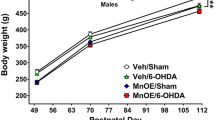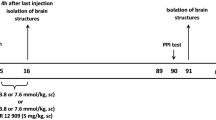Abstract
C57/BL6 mice were administered either7.5 mg Fe2+/ kg or vehicle (saline) postnatally on Days 10-12 after birth. From 64 days of age onwards for 24 days, groups of mice were administered either haloperidol (0.25 or 1 or 2 mg/kg, s.c.) or vehicle (Tween-80). Twenty-four hours after the final injection of either neuroleptic compound or vehicle, spontaneous motor activity was measured over a 60-min interval. Postnatal Fe2+-treatment (7.5 mg/kg, postnatally) reduced motor activity parameters during the initial 20-min periods (0-20 and 20-40 min) and then induced hyperactivity during the final 20-min period over all three parameters of activity, confirming previous observations. Subchronic administration of haloperidol, at the 1 and 2 mg/kg doses, and to a lesser extent the 0.25 mg/kg dose, increased the levels of activity in all three motor activity parameters in postnatal iron-treated mice: locomotion (1st and 2nd 20 min periods), rearing (1st and 2nd 20 min periods) and total activity (1st 20 min period). All three doses of haloperidol abolished the later hyperactivity in iron-treated mice, with the exception of the 0.25 mg/kg dose with regard to rearing behaviour. Apomorphine (1 mg/kg, s.c.)-induced activity was elevated by postnatal iron administration and by subchronic administration of apomorphine at the higher dose levels. In the context of these and other observations, it is suggested that subchronic administration of haloperidol interacting with postnatal iron induces different expressions of dopamine neuron comorbidity underlying movement disorder.
Similar content being viewed by others
References
Archer T, A Fredriksson, G Jonsson, T Lewander, AK Mohammed, SB Ross and U Soderberg (1986) Central noradrenaline depletion antagonizes aspects of d-amphetamine-induced hyperactivity in the rat.Psychopharmacology 88, 141–146.
Archer T, N Schröder and A Fredriksson (2003) Neurobehavioural deficits following postnatal iron overload: II Instrumental learning performance.Neurotoxicity Res. 5, 77–94.
Ben-Shachar D and MB Youdim (1990) Neuroleptic-induced super-sensitivity and brain iron: I. Iron deficiency and neurolepticinduced dopamine D2 receptor supersensitivity.J. Neurochem. 54, 1136–1141.
Ben-Shachar D and MB Youdim (1991) Intranigral iron injection induces behavioural and biochemical “parkinsonism” in rats.J. Neurochem. 57, 2133–2135.
Ben-Shachar D, B Pinhassi and MB Youdim (1991) Prevention of neuroleptic-induced dopamine D2 receptor supersensitivity by chronic iron salt treatment.Eur. J. Pharmacol. 202, 177–183.
Ben-Shachar D, E Livne, I Spanier, R Zuk and MB Youdim (1993) Iron modulates neuroleptic-induced effects related to the dopa- minergic system.Isr. J. Med. Sci. 29, 587–592.
Boye SM and PP Rompre (2000) Behavioural evidence of depolarization blockade of dopamine neurons after chronic treatment with haloperidol and clozapine.J. Neurosci. 20, 1229–1239.
Dexter DT, FR Wells, F Agid, Y Agid, AJ Lees, P Jenner and CD Marsden (1987) Increased nigral iron content in postmortem parkinsonian brain [letter].Lancet 2, 1219–1220.
Dexter DT, A Carayon, F Javoy-Agid, Y Agid, FR Wells, SE Daniel, AJ Lees, P Jenner and CD Marsden (1991) Alterations in the levels of iron, ferritin and other trace metals in Parkinson’s disease and other neurodegenerative diseases affecting the basal ganglia.Brain 114, 1953–1975.
Fredriksson A and T Archer (2003) Effect of postnatal iron administration on MPTP-induced behavioural deficits and neurotoxicity: behavioural enhancement by L-Dopa.Behav. Brain Res. 139, 31–46.
Fredriksson A and T Archer (2004) Neurobehavioural deficits associated with apoptotic neurodegeneration and vulnerability for ADHD.Neurotoxicity Res. 6, 435–456.
Fredriksson A, N Schroder, P Eriksson, I Izquierdo and T Archer (1999) Neonatal iron exposure induces neurobehavioural dysfunctions in adult mice.Toxicol. Appl. Pharmacol. 159, 25–30.
Fredriksson A, N Schroder, P Eriksson, I Izquierdo and T Archer (2000) Maze learning and motor activity deficits in adult mice induced by iron exposure during a critical postnatal period.Brain Res. Dev. Brain Res. 119, 65–74.
Fredriksson A, N Schroder, P Eriksson, I Izquierdo and T Archer (2001) Neonatal iron potentiates adult MPTP-induced neurodegenerative and functional deficits.Parkinsonism Relat. Disord. 7, 97–105.
Fredriksson A, N Schroder and T Archer (2003) Neurobehavioural deficits following postnatal iron overload: I Spontaneous motor activity.Neurotoxicity Res. 5, 53–76.
Fredriksson A, P Eriksson and T Archer (2006) Postnatal ironinduced motor behaviour alterations following chronic neuroleptic administration in mice.J. Neural Transm. 113, 137–150.
Gerlach M, D Ben-Shachar, P Riederer and MB Youdim (1994) Altered brain metabolism of iron as a cause of neurodegenerative diseases?J. Neurochem. 63, 793–807.
Glowinski J and LL Iversen (1966) Regional studies of catecholamines in the rat brain. I. The disposition of [3H]norepinephrine, [3H] dopamine and [3H]dopa in various regions of the brain.J. Neurochem. 13, 655–669.
Janetzky B, H Reichmann, MB Youdim and P Riederer (1997)Iron and Oxidative Damage in Neurodegenerative Diseases (Wiley-Liss, Inc.), pp 407–421.
Kirk R (1995)Experimental Design: Procedures for the Behavioural Sciences (Brooks/Cole:Belmont, CA).
Riederer P, E Sofic, WD Rausch, B Schmidt, GP Reynolds, K Jellinger and MB Youdim (1989) Transition metals, ferritin, glutathione, and ascorbic acid in parkinsonian brains.J. Neurochem. 52, 515–520.
Saldana M, M Bonastre, E Aquilar and C Marin (2006) Role of nigral NFkappaB p50 and p65 subunit expression in haloperidolinduced neurotoxicity and stereotyped behaviour in rats.Eur. Neuropsychopharmacol. 2006 Feb 22; [Epub ahead of print].
Schroder N, A Fredriksson, M Vianna, R Roesler, I Izquierdo and T Archer (2001) Memory deficits in adult rats following postnatal iron administration.Behav. Brain Res. 124, 77–85.
Yehuda S and MB Youdim (1989) Brain iron: a lesson from animal models.Am. J. Clin. Nutr. 50 (3 Suppl.), 618–629.
Youdim MB (2001) Deficiency and excess of iron in brain function and dysfunction.Nutr. Rev. 59, S83-S85.
Youdim MB, D Ben-Shachar and P Riederer (1991a) Iron in brain function and dysfunction with emphasis on Parkinson’s disease.Eur. Neurol. 31, 34–40.
Youdim MB, D Ben-Shachar and P Riederer (1991b) The possible role of iron in the etiopathology of Parkinson’s disease.Mov. Disord. 8, 1–12.
Youdim MB, E Grunblatt and S Mandel (1999) The pivotal role of iron in NF-kappaB activation and nigrostriatal dopaminergic neurodegeneration. Prospects for neuroprotection in Parkinson’s disease with iron chelators.Ann. NY Acad. Sci. 890, 7–25.
Author information
Authors and Affiliations
Corresponding author
Rights and permissions
About this article
Cite this article
Fredriksson, A., Archer, T. Subchronic Administration of Haloperidol Influences the Functional Deficits of Postnatal Iron Administration in Mice. neurotox res 9, 305–312 (2006). https://doi.org/10.1007/BF03033321
Received:
Revised:
Issue Date:
DOI: https://doi.org/10.1007/BF03033321




